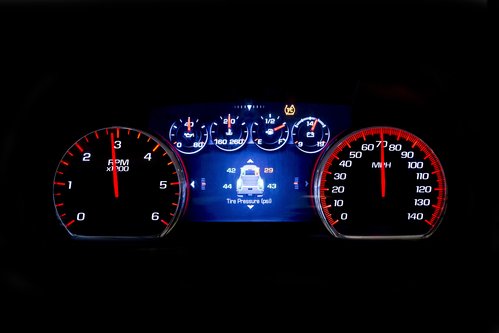What is TPMS?
TPMS stands for Tire Pressure Monitoring System. The system tells the vehicle when tire pressure is low.
This could be for one tire or multiple tires. When a tire pressure gets to about 25% lower than the recommended pressures a yellow light on the dash will appear.
Manufacturer recommended tire pressures can be found on the white and yellow sticker on the driver side door jam.
Tire pressure monitoring systems are required by law.
All vehicles sold (light motor vehicles) after Sept 1st, 2007 had to have a TPMS system in place.
This was partly due to problematic tires causing hundreds of deaths and a massive tire recall pushing Congress to do something about it.
How does TPMS work?
There are two different tire pressure monitoring systems in vehicles today. Direct and Indirect.
Direct TPMS
A sensor is placed in or on each wheel or tire and sends a radio frequency to the receiver in the vehicle.
Sensors are usually either attached to the tire valve stems or attached via a band on the inside of each wheel.
Indirect TPMS
An indirect tire pressure monitoring system uses sensors already on the vehicle. The rotation wheel speed from the ABS sensors is used to detect a difference in revolutions of the wheels.
For example, if one tire is significantly under-inflated, the overall diameter will be smaller. If a difference is detected then a signal is sent to the vehicle computer.
A warning light will then appear on the dash. This system may not be accurate when all four tires lose pressure at the same time.
TPMS Warnings
There two types of warnings to let you know that pressure is low, depending on the vehicle and its age.
One system will be able to tell you what the pressure is, in each tire with a diagram.
Other warning systems will simply light the dash warning light to alert the driver that a tire has low pressure.
With this system, it doesn’t tell you which tire is low or by how much. Checking all four tires will have to be done in this instance.
Why is monitoring tire pressure so important?
It’s important to monitor tire pressure because when tire pressure is low it can cause poor handling, braking, and fuel efficiency.
TPMS systems can also alert the driver to punctures, and other tire problems.
Note the TPMS will not function properly and the light will come on if a wheel is replaced with the spare.
Learn more about tire pressures.
“Tire-Pressure Monitoring System.” Wikipedia, Wikimedia Foundation, 22 Oct. 2017, en.wikipedia.org/wiki/Tire-pressure_monitoring_system#Indirect_TPMS



Recent Comments